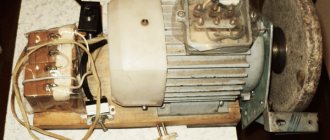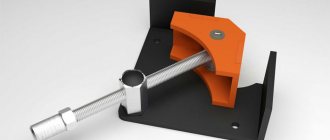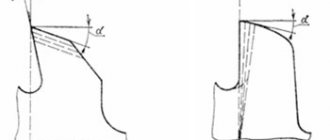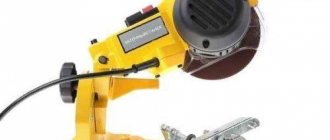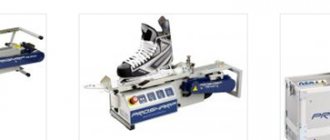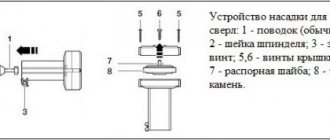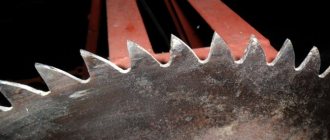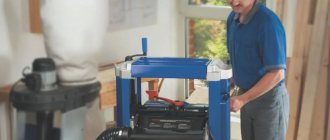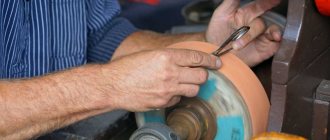Any cutting tool tends to become dull during use. This also applies to carbide saw blades, which must be sharpened regularly in order for wood to be sawed quickly and efficiently.
The easiest way to sharpen teeth on a circular saw is to use a regular file. But when working with your own hands, to bring the cutting tool into working condition, many difficulties arise that only a good specialist with sufficient experience can cope with. It is much easier, faster and more efficient to use a homemade machine for sharpening circular saws or a sharpening machine for circular knives for this operation.
Machine for sharpening circular saws Monolit TD1-600
If you have a homemade electric sharpening machine for circular saws, regardless of whether it is a factory tool or a homemade one, you should know the basic principles of using such equipment. Especially when there is a need to sharpen the teeth of saw blades that have different geometries and sharpening angles.
Machine
A machine for sharpening circular saws is not just one device. This can be called a large group of equipment and tools for special purposes.
– Automatic. The sharpening process is completely mechanized and there is no need for human participation. Such devices are used for production purposes.
- Manual. These can be any devices and tools for sharpening by hand. The productivity of such equipment is much lower than automatic machines. This type has found application in handicraft workshops for domestic needs.
Equipment of this kind is available for sale in a wide range; devices may differ in function, power and price. A manual machine for sharpening circular saws, the price of which will be much lower (about 20 thousand rubles), can be made independently. The equipment consists of dense and hard alloy plates that serve as cutters.
Plates for them are made from alloys of various compositions.
Differences in insert teeth
The tooth of hard alloys has four main planes for work: front, back and lateral (auxiliary). When the planes intersect with each other, cutting edges are formed: the main one and a pair of auxiliary ones.
The shape of the teeth is as follows:
- Direct. The use of this form will be justified when longitudinal cutting is required, which is quick in time and not required in quality.
– Oblique or beveled. The angle of inclination of the rear shape can be right or left, they alternate with each other. This configuration is the most common. Sharpening blades of different sizes are used to work with different materials in any direction.
– Trapezoidal. This tooth dulls its edges more slowly than a beveled tooth. Alternate it with the straight one. In this case, the rough cut was a longer trapezoidal cut, and the finishing cut was a short straight cut.
– Conical. This form of teeth performs a rough cut on the lower edge of the boards, while protecting the upper edge from chipping. Basically, the front edge of such an element is flat. But if you make it concave, then it is possible to use this device for cross cutting in a finishing version.
Read also: Contactor designation on a single-line diagram
Purpose
During the processing of workpieces, circular saws can become dull and cause the following negative consequences:
- increased load on the electric motor;
- uneven cutting line, damage to the ends of parts;
- increased cutting time for workpieces.
If there is relatively little wear on the cutting edges and tooth profile, sharpening is sufficient. The solution to the problem is as follows:
- use hand tools;
- perform work on a disc sharpening machine.
The first option is difficult to implement and requires skills in carrying out such work. It is very labor-intensive, time-consuming, and requires careful selection of hand tools for each type of circular saw.
Machine sharpening is much easier to implement, since it only requires the selection of a grinding wheel and precise setting of the sharpening angle. The processing speed is high, so this method is in demand in industrial and private sectors.
Sharpening angles
The fundamental angles are those determined by the shape of the teeth. These are front and rear, as well as bevel along the front and rear planes.
For longitudinal cutting of the front angle, it is recommended to set the degree in the range from 15 to 25. For transverse cutting - 5-10 degrees. For universal saws of both sections, it is more correct to choose the average value of 15 degrees.
The size of the angle is also determined by the hardness of the cutting material.
You can buy a machine for sharpening carbide circular saws at a cost of 15,000 rubles. You can also shell out for more expensive devices. For example, PP-480Z will cost its owner 280,000 rubles. Prices vary and depend on the purpose of the device, its functions, power and performance. For a small workshop or home use, you can purchase a JMY8-70 circular saw sharpening machine. Its cost is within 18,000 rubles.
How to know when it's time to sharpen your circular saw
Sharpening a circular saw should only be done when necessary. You can recognize the onset of such a moment by two clear signs. In particular, urgent sharpening of a wood circular saw is necessary:
- If strong heat regularly occurs on the safety guard of the saw in the area of the electric motor. In some cases, with such an increase in temperature, smoke is released under the casing.
- With strong pressure on the tool to obtain a good cut while processing the material.
- If dark marks appear, traces of soot on the wood and a characteristic smell of burnt wood. This occurs due to the fact that the teeth of the saws are dull.
Sharpening rules
The main wear of saw teeth occurs on the top edge, which is directly involved in cutting. Its rounding can be 0.3 mm. The central face changes earlier than the others.
– We must not allow significant wear on the saw. The edge can be rounded no higher than 0.2 mm. It is more difficult to sharpen a saw that is duller than this value. This will take longer than for a tool with normal wear. The degree of wear is determined either by the type of cut or by the teeth.
– We must not forget about the maximum possible number of sharpenings performed. This value is in the range of 30-35 times. To achieve this result, both surfaces are treated at once.
– Before starting work, you should clean the working disk from dirt, and also measure the angles of inclination. Preparation for sharpening is carried out from the front of the tooth. The layer of metal that can be removed is 0.20 mm.
– If abrasive diamond wheels are used for sharpening, they must be cooled with a liquid of a special composition (coolant). For better quality and lower specific gravity, it is better to choose a high-grit wheel.
– Jagged edges and irregularities should not be allowed, even if this is a homemade machine for sharpening circular saws. They can lead to untimely exit from work and crumbling of the metal.
Specifications
Machines for sharpening saw blades have the following technical characteristics:
- the diameters of the grinding wheels used are from 100 to 480 mm;
- electric motor power - up to 380 W;
- tolerance on the diameters of the processed saws - from 65 to 630 mm;
- the diameters of the mounting holes for installing the sharpening wheel are from 12.7 to 32 mm;
- the maximum thickness of the removed layer for one tooth is up to 0.2 mm per pass;
- power type - single- or three-phase network;
- type of transmission from the motor shaft to the fixed grinding wheel - belt or gear;
- sharpening angle range - from 00 to 300;
- engine shaft rotation speed - up to 2900 rpm;
- Possibility of sharpening the following tooth profiles - straight, beveled, trapezoidal, conical.
Adjusting the machines is quite simple; it is important to know only the correct sharpening angles. You can find out their exact values in the reference books or technical specifications in the attached documentation.
Correct sharpening angles
artisanal
Sharpening it yourself won’t be too difficult. Especially if you have the necessary equipment. And if not, then you can make it yourself. You can make a machine for sharpening circular saws, the price of which will only please you, from simple parts. To do this you will need the following basic elements:
The circle is fixed on the engine, the disk blade is on the caliper, the screws will ensure the movement of the workpiece along the axis of the circle, which will provide the desired angle.
The main task for such an element as a machine for sharpening circular saws is to fix them in the required position relative to the circle. This is necessary to accurately maintain the angles; this can be provided by a stand mounted on the machine frame in the same plane as the circle.
When placing the disk on a stand, the teeth must be perpendicular to the plane of the sawing machine.
Circular saw and means of sharpening it
You can sharpen a circular saw with a wheel made of silicon, CBN or diamond. The choice of wheel material depends on what the saw teeth are made of.
IMPORTANT TO KNOW: Assembling a sheet bending machine with your own hands
If the cutting blade of the saw is steel, then it is good to sharpen it using CBN wheels. But when a row of teeth is made of carbide, it is better sharpened by a silicon or diamond wheel.
Carbide cutters are sharpened at a wheel speed of about 18 meters per second.
This means that if a diamond wheel with a diameter of 12.5 cm is used, the engine must make more than 1500 revolutions per minute. Less hard alloys wear out more slowly.
By sharpening the saw blade on a machine, you can change the position of the saw blades relative to the grinding wheel using several methods.
Sometimes it is enough to move only the saw blade, sometimes only the motor and the wheel. But in some cases it is necessary to move both the saw and the diamond wheel simultaneously.
There is a wide variety of sharpening machines, they have different functions. Highly priced machines are equipped with a special program that controls automatic operation without personnel supervision.
Simple models are cheaper. They require the participation of a worker who must fix the saw so that it is at the desired sharpening angle.
Video:
All further operations are also carried out by hand. You will need to turn the saw around its axis, submit it for grinding and observe how much metal is removed from each tooth.
That’s why it’s better to work on a simple machine at home, when you need to sharpen dull saw blades from time to time.
The most basic device for sharpening saw blades includes two main components in its system. These components are a motor equipped with a wheel, and a support where the saw itself is placed.
In addition, the machine has a rotating mechanism that changes the angle of inclination of the saw blade. The screw of this system ensures the displacement of the saw along the axis of the sharpening wheel.
This operation sets the desired value for the sharpening angle at the front.
The screw also helps set the stopper in the required position, preventing the wheel from going too deep into the space between the teeth.
Exploitation
Before you start making this unit yourself, you need to think through the drawings of a machine for sharpening circular saws. You can calculate them yourself, or you can turn to a professional. In any case, in order to understand all the intricacies of the future device, you cannot do without a preliminary paper version. If you have the necessary knowledge, you can cope without turning to a specialist.
A machine for sharpening circular saws, created with your own hands, has a big advantage in terms of price over a factory unit. It also does not require any special skills to operate.
Selection principles
Machine equipment for saw blades should be selected based on the following principles:
- functional and technical characteristics of machines;
- permissible diameters of installed grinding wheels;
- accuracy, turning angle setting range;
- electric motor power;
- dimensions, weight of equipment;
- manufacturer, warranty and service periods provided;
- level of automation;
- equipment maintainability;
- compliance of machines with safety standards when sharpening.
Advantages and disadvantages
The advantages of machines for sharpening circular saws are:
- high sharpening speed;
- uniform sharpening, precision processing;
- turning angle adjustment;
- ease of setup and equipment maintenance;
- experience in carrying out this type of work is not required;
- control of pressure on the grinding wheel.
You can assemble the turning machine yourself. To do this, it is allowed to use inexpensive components and available materials. The design is quite simple, so assembly requires a minimum of tools.
The disadvantage is the need to use a set of grinding wheels, which need to be rearranged depending on the profile of the cutting edges. Grinding wheels with the following parameters are required:
- thickness - from 16 to 40 mm;
- diameter - from 100 to 250 mm (industrial options up to 650 mm).
Manufacturers and cost
The following manufacturers produce sharpening machines:
- Kaindl (Germany);
- WTG (China);
- ABM (Türkiye);
- LAKFAM (Poland);
- Griggio (Italy);
- Kamsky Bereg LLC (Russia);
- CJSC Lipetsk Machine Tool Enterprise (Russia);
- JSC "Astrakhan Machine Tool Plant" (Russia).
Cost of sharpening equipment in Russia:
- industrial semi-automatic - from 588 thousand rubles;
- compact with manual adjustment - from 17 thousand rubles;
- automatic industrial - from 2.683 million rubles.
Compact disc sharpening machine
Sharpening without a machine
You can sharpen a saw at home without the help of a machine. But you shouldn’t hold it by hand while sharpening on a grinding wheel. For correct operation, hand effort will not be enough, and the eye will not be able to adjust the desired angle. To simplify the task, you can use some kind of fixation device; for this purpose, a regular flat delivery will be useful. The axis of the sharpening disk must coincide with the surface of the stand. And the circle, in turn, should be placed perpendicular to the saw. If it is necessary to make corners, the structure is made movable using hinges. But here the difficulty arises in maintaining the same angle of the front and rear sharpening. Rigid fixation of the saw wheel in relation to the abrasive disc will help to avoid this. This can be done by using an arbor groove or attaching stops in the stand, which will allow you to secure the corner.
Types of teeth
The main cutting element of the disc is the teeth. They are made from carbide material. A tooth consists of four sides: front, back and two sides. Also from the main cutting edge and two additional ones.
Teeth requiring sharpening are divided into:
- Direct. Used for longitudinal sawing of blades.
- Beveled. They have an angular cut on the back plane of the tooth. They can cut not only wood, but also plastic or chipboard.
- Trapezoidal. In cross-section, the cutting plane has the shape of a trapezoid. Thanks to this, they can be sharpened less often.
- Conical. They have the shape of a cone.
Disc tooth shape
According to GOST, any carbide tooth in a circular saw must have four working planes (front, back and two side) and three cutting edges (one main plus two auxiliary). But at the same time, the shape of the teeth of circular saws can still be different:
- straight;
- oblique;
- trapezoidal;
- conical
One or another option should be chosen in accordance with the tasks facing the master.
Note! To properly sharpen a tool, the master must determine the shape of the teeth, as well as the material from which the saw itself and its cutting elements are made.
A circular saw with straight teeth is best used for longitudinal sawing of wood when high quality is not required.
Oblique teeth on a circular saw are characterized by the fact that they have a beveled rear (and sometimes front) plane and an alternating angle of inclination (either to the right or to the left).
Saws of this format are considered the most common. They are used for sawing wood products in the transverse and longitudinal direction. In addition, this configuration of the teeth is convenient for trimming materials with double-sided lamination—there are no chips along the edges of the cut line.
Trapezoidal teeth are able to maintain their original sharpness for a long time. On many models of circular saws they often alternate with the straight teeth already described. Trapezoidal ones are always taller - by this criterion they can be calculated. It is important to understand that trapezoidal teeth play the main role when rough sawing wood, and straight teeth play a major role when cutting wood.
As for conical teeth, it is important to use them in some auxiliary operations. For example, when a layer of laminate needs to be cut a little first, so that further fragments do not appear during sawing.
Sharpening angles
A circular saw has four corners that need to be sharpened after dulling. These are the front and back angles. Also the cutting angles formed by the front and back surfaces.
Depending on the direction of sawing, they need to be sharpened correctly. When longitudinal cutting, the rake angle ranges from 15 to 25 degrees. In the case of cross cutting, the sharpening angle is reduced to 5-10 degrees. If universal cuts are required, then the tooth is sharpened at an angle of 15 degrees.
The density of the material has an important influence on the angle. The lower it is, the more urgently the tooth is needed. If the material being processed is plastic, then the angle can be negative.
Sharpening circular saws with pobedit tips
It is not easy to maintain sharpening angles for circular saws with carbide tips because pobedite is applied to the tooth. This alloy is attached by soldering. The geometry of the cutting part is complex, and the sharpening parameters require precise control.
Work is carried out by smoothing the cutting edge to a radius of 0.3 mm. A greater value should not be allowed.
Recommendations for sharpening:
- Sharpening is carried out on the front and back planes of the tooth. If the work is carried out correctly, then the total number of sharpenings until the blade is completely worn out will be 30 times.
- You should start working from the front plane.
- The part of the tooth that is soldered must fit tightly to the abrasive wheel.
- Turning time ranges from 3 to 5 seconds. Can't go any longer. This leads to excessive heating of the metal. It is overheated and tempered with a decrease in hardness.
- The thickness of the material being ground is around 0.15 m.
The principle and angle of sharpening circular saw blades
The working part of a circular saw is sharpened at 4 main sharpening angles. They relate to the main technical parameters of the cutting disc, as well as the type of shape of the cutting teeth.
It is worth noting that all circular saw teeth are characterized by front (γ), rear (α) angles, as well as the cutting angle of the front and rear surfaces (ε1 and ε2). The value of each specified angle must correspond to the purpose of the sawing devices, the materials being cut and the direction of sawing.
In particular, the rip saw is sharpened at fairly large rake angles (15° - 25°).
The sharpening indicators of the front corners for transverse types of cuts are in the range of 5° - 10°. Universal options, used for processing materials in all types of directions, are standardly sharpened at 15°.
At the same time, the value of the specified angle is also influenced by the fact of how hard the objects being cut have. Their value has a strict dependence: with greater hardness of the material that is being cut, the cutting teeth should be less pointed.
According to the main principle of sharpening teeth on a carbide saw blade, it is important to take into account that during long-term operation the most significant wear processes occur on the upper cutting edges. As a result, with intensive use, their lines can be rounded up to 0.3 mm or more. Regarding the tooth planes, it is worth noting that the greatest wear occurs on the front surfaces.
When properly sharpening a cutting element, the cutting edges must be shaped in such a way that the radius of their roundings does not exceed 0.2 mm. In this regard, it is recommended to perform parallel grinding of the metal on the front and rear planes of the teeth. The use of this method is considered the most appropriate. It is possible to sharpen only one front plane, but in such cases this operation requires more time. In addition, the teeth will grind down faster, since it becomes necessary to grind off a larger layer of metal from the front surfaces.
The standard layer for grinding metal is 0.05-0.15 mm.
Application of the machine
The simplest machine for working at home is a motor with an abrasive. The wheels can be diamond, CBN or silicon carbide.
It is difficult to keep the blade in a certain position relative to the abrasive. You need to use the tools. This can be a horizontal stand or a fixing device, where the upper plane must coincide with the axis of the abrasive.
The tooth to be sharpened is located on the plane so as to be perpendicular to the blade. After turning on the engine, the blade is brought to the circle and pressed against it with a tooth. The layer of metal being removed is regulated by the pressing force. Having finished working with one tooth, the next one is approached using the same method. And so on in a circle until the end.
For the purpose of universalization, the stand is being modernized. The front part is made movable, and a pair of bolts are screwed into the rear. With their help you can adjust the tilt of the canvas. It becomes possible to sharpen the front and back planes of an oblique tooth.
The problem of maintaining the same front and rear sharpening angles remains. To do this, it is necessary to fix the blade relative to the center of the abrasive wheel. To do this, the disk is inserted into a special mandrel, and a groove is made in the stand for it. The required sharpening angle is maintained by moving the mandrel along the groove. If the diameter of the disks is different, then it must be possible to move the engine or stand with a groove.
Another way is to install stops that will fix the desired position of the disk.
How to sharpen a disc with a machine
To restore the integrity of cutting discs, two methods are used - manual and automated. Performing the procedure manually is not only difficult, but also time-consuming. That is why it makes sense to buy a sharpening machine for saw blades or make the device yourself.
A simple device for sharpening saw blades is considered to be a sharpener or an emery machine, on the shaft of which you need to attach a special wheel - diamond, CBN, or sputtered silicon carbide. The difficulty in implementing the process is that the equipment being sharpened must be fixed in a stationary position, so holding the disc in your hands while sharpening it is not recommended. This is not only dangerous, but also reduces the quality of sharpening.
This is interesting!
Before starting work, it is necessary to clean the surface of the equipment being sharpened from carbon deposits.
To do this, you can use kerosene, diesel fuel or industrial cleaners. If you do not clean it, the performance of the nozzle can be restored to 75% -80%. Instructions for properly sharpening cutting blades for circular saws:
- Each tooth that is sharpened must be perpendicular to the blade.
- The principle of sharpening is that each tooth of the disk must be brought to the rotating blade (diamond wheel).
- The amount of metal layer removed depends on the magnitude of the clamping force. The more wear or abrasion of the teeth, the more firmly the tool should be pressed against the blade.
- The procedure is performed in a similar way for each link
To sharpen circular saw blades, you do not need to buy special equipment. To a home sharpening machine you need to attach a stand, which consists of a fixed and movable part, as well as a mount. With this device you can easily and quickly sharpen at home.
The task becomes more complicated when it is necessary to maintain the appropriate sharpening angle. To modernize and expand the functionality of the installation, you will need to make a tilt regulator for the movable stand. Bolts and nuts are used as regulators, through which you can set the required angle of inclination of the stand.
The movable stand is a square frame, in the center of which there is a lock for installing the disk. The clamp has the same diameter as the sharpened equipment. A groove is made in the stand through which the required sharpening angle is maintained. It is not difficult to carry out sharpening work, therefore, if you frequently work with wood using a circular saw, it is necessary to make a sharpening machine.
This is interesting!
Carrying out sharpening work in an automated way is much faster and easier, but this will require special equipment. The manual method in this regard does not require any equipment other than a file.
